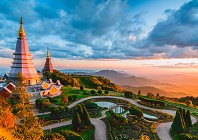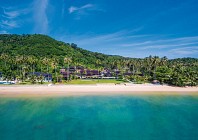Traditionally, travellers to Thailand with a bit of cash to splash have had one option and one option only: the large, luxury hotel complete with archetypal Thai architecture and a never-ending breakfast buffet. Enter 2012, however, and things are changing.
Not only is the hotel scene in the Land of Smiles becoming increasingly competitive, a younger generation of travellers from all over the world is landing in Bangkok and demanding something a little bit different.
“Hotels have to find a twist,” says Rujiraporn Wanglee, founder of PIA Interior, the firm responsible for the interior design of two of Bangkok’s newest boutique-style hotels, Sofitel So Bangkok and Hotel Muse. “People don’t just want a nice hotel; they want an experience, something to remember.”
And that doesn’t just mean a master mixologist and an iPad ordering system; discerning travellers visiting Thailand also want evolutionary architecture and designs that don’t follow the rules.
“Because of this, small boutique hotels with really cool designs are popping up and our own people, our own young designers, are coming out and refusing to follow orders, refusing to follow what’s been done before,” says Supakanya Lindsay, senior associate at Bangkok-based architecture firm Hassell, who was involved in the design of Starwood’s Aloft Bangkok, the brand’s first hotel in Thailand, which opened in May 2011.
Meeting the needs of this new generation means thinking outside the box, according to award-winning Thai architect Smith Obayawat, the man behind the architecture of 30-storey urban design hotel Sofitel So Bangkok, which opened earlier this year. “When designing a highrise building like this on a small plot of land, everybody does a box,” he says. “But I was thinking, ‘What difference can I make to the typical box?’”
Obayawat decided to divide the hotel into four separate boxes, creating the feeling of four small boutique hotels in one, each with a completely different style of room.
“We wanted to create a hotel that is liveable and not boring, and when the owner saw what I’d prepared, he asked whether we could choose four designers. I said, ‘Why not five? One for the public spaces and one for each of the different kinds of rooms’,” he recalls. “We’ll be the talk of the town and celebrate our Thai designers.”
And that’s exactly what they did. Sofitel So Bangkok now boasts four different areas of themed accommodation, one based on water and designed by Pongthep Sagulku of August Design; one on earth, created by Vitoon Kunalungkarn of IAW Design; the third centred around wood and conceptualised by Nithi Sthapitanonda, the award-winning founder of 49 Group; and the final section inspired by metal and put together by Somchai Jongsaeng of Deca Atelier. The public spaces, which draw inspiration from the fire element, were brought into being by Wanglee herself.
For Wanglee, fire was the perfect element for the public spaces of a Bangkok-based hotel. “It’s a city that never sleeps and a city with a lot of energy. And I interpreted the fire element in that sense so we were able to put a lot of energy into the design,” she explains.
In amongst the excitement and individuality of Sofitel So, tradition has not been forgotten. For example, the signature adornment of the wood element rooms is a hand-sketched Siamese mural, while the lobby houses both traditional Thai artwork and a contemporary Christian Lacroix-designed European creation.
RESPECT THE PAST
Homage to tradition is a theme that runs through each and every one of Bangkok’s recently-opened design hotels. Although discerning visitors are increasingly looking for something more memorable than age-old luxury, they don’t want to lose that unmistakable Asian flavour.
For Eugene Yeh, who personally appointed each of the eight bedrooms in recently-opened Cabochon, an opulent boutique hotel in the elegant four-storey Walpole Building located in the heart of Bangkok’s Sukhumvit district, this was particularly pertinent.
The hotel’s elegant interiors were conceptualised to recreate the Shanghai chic of the 1920s, inspired by Yeh’s many trips to the city. “I love tradition, so building Cabochon, before many traditional building skills are lost, was one of my dreams and a tribute to those old legendary pieces of architecture around Shanghai,” he explains, adding that while Bangkok has certainly started embracing the modern and the simple, elements such as the traditional Thai-style roof will never disappear.
Cabochon’s eight studios and suites, ranging from 26-58 sq m, are filled with vintage-style furniture that captures the chic vibe of Shanghai in the roaring 20s, with hardwood floors in the living room and bedrooms and polished marble floors in the bathrooms. Balconies featuring double-leaf French doors and balustrades are framed by climbing plants and flowers, creating a whimsical colonial feel in Downtown Bangkok.
At Hotel Muse, part of Accor’s design-driven MGallery collection, the hotel’s interior design firm, PIA Interior, was focused on creating something reminiscent of turn-of-the-century Thailand, but with a twist.
An effortless blend of European and Siamese styles, Hotel Muse mixes turn-of-the-century grandeur with decidedly contemporary elements and juxtaposes classic European touches with ornate Asian motifs. “We didn’t want to do ‘history’ history,” explains PIA associate Pruitsatorn Sakulthai.
“We wanted to create a contemporary look – almost a twist on history. We wanted to create something timeless and give some value for the new generation.”
Even at Aloft Bangkok, which many may describe as a cookie-cutter hotel, this blend of up-to-the-minute modernity and tradition can clearly be seen. As well as its sophisticated technology and palpably urban feel, you can’t miss the typically Thai fabrics and local artwork.
For Lindsay, this was the main challenge she faced when designing the hotel. “We had to stick to the brand but still try to find some Thai flavour,” she explains. “We achieved this by using Thai materials such as silk, Thai decorations and props and a lot of Thai artwork.”
But modernity really is the name of the game at Aloft, which features exposed loft-like ceilings, and offers ‘touch rooms’, which you can access via your Aloft Smartphone, which also serves as an air conditioning control and TV remote, among other things.
“It doesn’t have much of the fussy detail; it’s quite industrial, and this really appeals to the younger generation,” Lindsay says. “The hotel is all about interaction, so we used vibrant colours, different textures and different finishes.” The lobby is also connected to the mezzanine level, which houses the popular W XYZ Bar, with a colour-changing glass floor.
In many ways, it’s difficult to compare an unashamedly contemporary hotel such as Aloft with a venue as focused on local tradition as Hotel Muse. But, really, that’s the point. As Bangkok’s hotel scene becomes increasingly saturated, the most forward-thinking owners and brands have started differentiating themselves from the competition by adding creative design twists to their projects, without losing the distinctive Asian flavour that has continued drawing travellers to the region.
It can safely be said that the traditional luxury experience that once characterised the Bangkok hotel scene is no longer the only option – by a very long shot.
Golden book
Sofitel So Bangkok
+66 2 624 0000
www.sofitel.com
Hotel Muse
+66 2 630 4000
www.hotelmusebangkok.com
Aloft Bangkok
+66 2 207 7000
www.alofthotels.com
Cabochon
+66 2 259 2871
www.cabochonhotel.com













